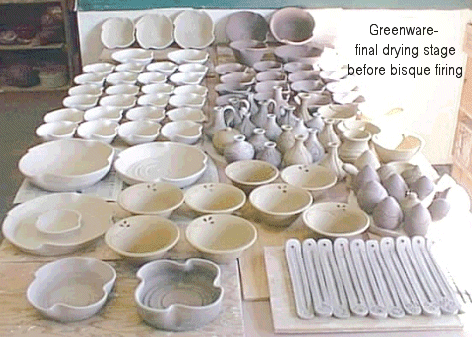|
LunaRayven Dreams Fine Pottery & Gifts
The Process:
On average, a single piece of glazed stoneware pottery is handled a minimum of 12 times before it reaches you, the buyer. Here's a breakdown of the process for a single mug.
- Wedging-The
clay is cut from the block and worked, or wedged for pliability and to
remove air.
- Weighing- Approx. 200 for an average mug.
- Throwing-The clay is placed on the wheelhead and shaped.
- Trimming-After
the clay has set up enough to handle, excess clay is trimmed off.
- Handle pulling and attatchment- A new wad of clay is attatched to the body of the mug and gently teased into the desired shape. When the desired length and thickness is achieved, the handle is attatched to the lower part of the mug body. Finishing touches and designs are usually added at this stage.
- Drying-Stage 1-The mug is then wrapped and placed in the greenware room, until it reaches the leather-hard satge.
- Drying Stage 2-When the mug has dried sufficiently, it's moved into the kiln room where it's allowed to dry further.
The pieces shown below are ready for the final drying process before being loaded into the first firing.

- Bisque Firing- When the clay body has dried sufficiently, the mug is then loaded into the kiln for bisque firing, depending on the potters preference
this can be anywhere from ^08 (1751° farenheit 955°/ centigrade) to ^01 (2079° farenheit /1137° centigrade), or higher. At this stage, the kiln may be stacked with ware touching, as they (usually) won't fuse at this point. A soak period of about 12 hours is usually preferred to draw out as much remaining moisture as possible.
The kiln is turned up to medium settings for 3-4 hours, then high for the remainder of the firing cycle, until the kiln sitter goes down, indicating that the disired temperature is reached.
-
Unloading bisque- After the kiln cools the ware is unloaded. Opening too soon results in dunting (warping) and/or cracking when drastic temperature changes occur. The ware is checked for flaws.
To continue to Raku firing click
Here
for stoneware, continue...
- Sanding and glazing- Rough edges are sanded from the bottom, and and any other rough spots are smoothed off. The mug is then wiped with a damp sponge,waxed (for glaze resist) and glazed.
- Glaze Firing- After the glaze is applied the mug is loaded into another kiln that fires to higher temperatures. Cone 5-6 stoneware (2185-2232° f/1196 °-2185c) Cone 9-11 Stoneware and porcelain matures at 2336° to 2399° F(2336° 2399° centigrade). Some clays (esp porcelain) can fire to ^14 (2491°F/2491°c ). During this stage, the kiln is packed so that none of the ware touches, as they will fuse together as the glaze melts, then hardens.
This firing cycle (depending on the potters' preference) follows as for the bisque, and the cooling period is longer. A good rule of thumb is that if you can stick a twisted paper cone through a peep hole and it doesn't burst into flames, your eyebrows are safe, and you can crack the kiln lid
open.
-
The kiln is then unloaded, and the mug is checked for flaws, the bottom sanded
if needed, rinsed, and priced, wrapped and shipped for sale.
Standard Disclaimer
You will find as many methods and firing cycles as you will potters, nothing here is written in stone, it's just a general guideline, of the way I do things.
Many potters use the single fire method, wherein the bisque firing is eliminated entirely.
|